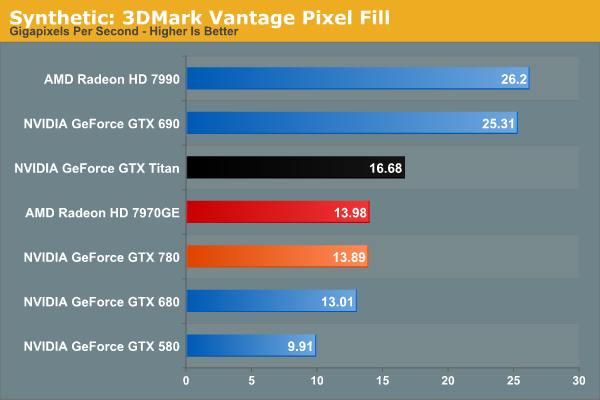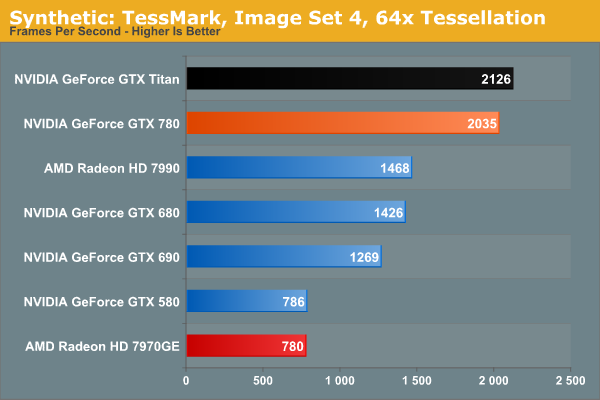NVIDIA GeForce GTX 780 Review: The New High End
by Ryan Smith on May 23, 2013 9:00 AM ESTSynthetics
As always we’ll also take a quick look at synthetic performance, though as GTX 780 is just another GK110 card, there shouldn't be any surprises here. These tests are mostly for comparing cards from within a manufacturer, as opposed to directly comparing AMD and NVIDIA cards. We’ll start with 3DMark Vantage’s Pixel Fill test.

Pixel fill is traditionally bound by ROP and memory throughput, but with enough of both the bottleneck can shift back to the shader blocks. In this case that’s exactly what happens, with the GTX 780 trailing GTX Titan by about the theoretical difference between the two cards. On the other hand it’s very odd to see the GTX 680 get so close to the GTX 780 in this test, given the fact that the latter is more powerful in virtually every way possible.
Moving on, we have our 3DMark Vantage texture fillrate test, which does for texels and texture mapping units what the previous test does for ROPs.

Unlike pixel fill, texel fill is right where we expected it to come in compared to cards both above and below the GTX 690.
Finally we’ll take a quick look at tessellation performance with TessMark.

NVIDIA’s tessellation performance is strongly coupled to their SMX count, so the high number of SMXes (12) on the GTX 780 helps it keep well ahead of the pack. In fact we’re a bit surprised it didn’t fall behind GTX Titan by more than what we’re seeing. On the other hand the lead over the GTX 580 is right where we’d expect it to be, showcasing the roughly trebled geometry performance of GTX 780 over GTX 580.










155 Comments
View All Comments
SymphonyX7 - Thursday, May 23, 2013 - link
*mildly/narrowly trailing the GTX 680chizow - Thursday, May 23, 2013 - link
AMD released some significant driver updates in ~Oct 2012, branded "Never Settle" drivers that did boost GCN performance significantly, ~10-20% in some cases where they were clearly deficient relative to Nvidia parts. It was enough to make up the difference in a lot of cases or extend the lead to where the GE is generally faster than the 680.On the flipside, some of AMD's performance claims, particularly with CF have come under fire due to concerns about microstutter and frame latency, ie. the ongoing runtframe saga.
Vayra - Thursday, May 23, 2013 - link
Drivers possibly?kallogan - Thursday, May 23, 2013 - link
High end overpriced gpu again ! Next !wumpus - Thursday, May 23, 2013 - link
Except that the 780 is nothing more than a Titan with even more cuda performance disabled. Presumably, they are expecting to get Titan sales to people interested in GPU computing, if only for geeklust/boasting.wumpus - Thursday, May 23, 2013 - link
My above comment was supposed to be a reply. Ignore/delete if possible.ifrit39 - Thursday, May 23, 2013 - link
Shadow Play is the most interesting news here. It costs a not-insignificant amount of money to buy a decent capture card that will record HD video. This is a great alternative as it requires no extra hardware and has little CPU/GPU overhead. Anything that ends up on the net will be compressed by youtube or other service anyway. I can't wait to remove fraps and install shadow play.ahamling27 - Saturday, May 25, 2013 - link
Fraps isn't the best, but they somehow have the market cornered. Look up Bandicam, I use it exclusively and I get great captures at a fraction the size. Plus they aren't cut up into 4 gig files. It has at least 15x more customization like putting watermarks in your capture or if you do like to segment your files you can have it do that at any size or time length you want. Plus you can record two sound sources at once, like your game and mic, or your game and whatever voice chat software you use.Anyway, I probably sound like I work for them now, but I can assure you I don't. This Shadow Play feature is definitely piquing my interest. If it's implemented wisely, it might just shut all the other software solutions down.
garadante - Thursday, May 23, 2013 - link
There were two things that instantly made me dislike this card, much as I've liked Nvidia in the past: completely disabling the compute performance down to 600 series levels which was the reason I was more forgiving towards AMD in the 600/7000 series generation, and that they've priced this card at $650. If I remember correctly, the 680 was priced at $500-550 at launch, and that itself was hard to stomach as it was and still is widely believed GK104 was meant to be their mid-range chip. This 780 is more like what I imagined the 680 having been and if it launched at that price point, I'd be more forgiving.As it is... I'm very much rooting for AMD. I hope with these new hires, of which Anandtech even has an article of their new dream team or some such, that AMD can become competitive. Hopefully the experience developers get with their kind-of-funky architecture with the new consoles, however underwhelming they are, brings software on the PC both better multithreaded programming and performance, and better programming and performance to take advantage of AMD's module scheme. Intel and Nvidia both need some competition so we can get this computer hardware industry a bit less stagnated and better for the consumer.
EJS1980 - Tuesday, May 28, 2013 - link
The 680 was $500 at launch, and was the main reason why AMD received so much flak for their 7970 pricing. At the time it launched, the 680 blew the 7970 away in terms of gaming performance, which was thee reason AMD had to respond with across the board price drops on the 7950/70, even though it took them a few months.